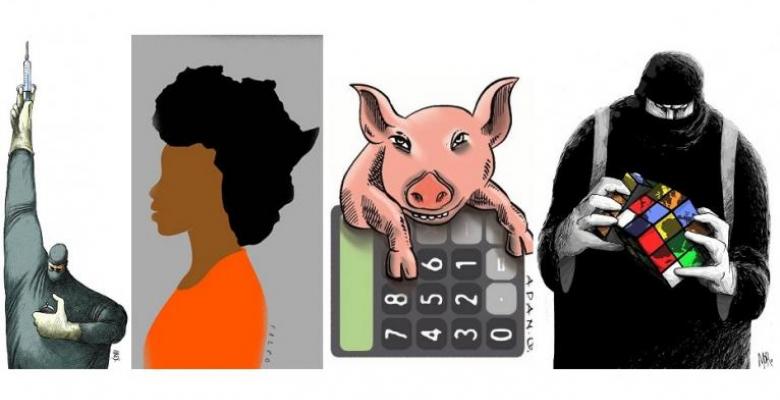Graphic Humor: between art and journalism

Cuba is holding these days the 22nd International Biennial of Graphic Humor, an event that has resorted to social networks due to the current sanitary contingency. CubaSí interviewed four of its participants in order to look for some information about this profession in the country.
CUBASI: There is an extraordinary tradition of graphic humor in Cuba. But let’s not talk about history. Let’s talk about today. What is the general panorama of this profession, here and now?
ARÍSTIDES HERNÁNDEZ (ARES): I believe that Cuban graphic humor is just fine. There was certain pause linked to what we all know as the special period; in the early years of this century new names emerged, who are now well-known. There are now several cartoonists, most of them young people who are doing an excellent work. They are great and boast international and national awards. To me, this is a sign that our tradition has successors. And some of them make graphic humor better, as they try new ways of doing.
CARLOS ALEJANDRO FALCO CHANG (FALCO): I think Cuba is experiencing a notable blossoming of its graphic humor. And I am not only referring to the already established cartoonists, but also the young artists emerging.
ADÁN IGLESIAS (ADÁN): I believe this is a high aesthetic value humor and strongly committed to its time, its culture. It fully represents our traditions.
CUBASI: What are the main subjects addressed by humor in Cuba? Which are the taboo subjects?
FALCO: It is pleasant to see how many subjects are addressed. We, who work in papers, we follow the official editorial line. And we also address costumbrismo and everydayness…
ARES: When you have a notion about what is going on in different world regions, you find out that a similar subject is not tackled the same way everywhere. In Cuba, there are very sensitive subjects; for instance, the one related to the historical leaders of the Cuban Revolution. In other places, you do not joke with religious leaders such as Mahomet. There are places where you cannot joke with media sponsors, or the King. The same way, it is impossible you find praises to the virtue of socialism in media opposed to the Revolution. Another sensitive subjects: Jews, the Holocaust, the skin color…
CUBASI: Which are the main spaces for the socialization of graphic humor in Cuba? Are they enough?
FALCO: The main spaces we have are social networks and online publications. We know printed publications are limited.
MICHEL MORO: It seems that talent and materials exceed the spaces graphic humor owns in mass media.
ADÁN: Sometimes, when you publish something in a printed media, is because there is a void and we have to fill it. But the conception of doing journalism, with graphic journalism as part of it, is not often valued or taken into consideration in the routines of mass media.
MICHEL MORO: And not only in printed media, we need more graphic humor in digital media as well. In printed media, well-established cartoonists are usually the only ones who publish in printed media. And there are young cartoonists who could also showcase their work. We should understand better what is the role and importance of graphic humor in the conception of journalism.
CUBASI: Is it art or journalism? Some still underestimate this art expression and believe it is in nobody’s land.
ARES: The truth is that graphic humor is an artistic expression closely related to journalism. It is art and journalism. And such dualism is not often understood. The fact of being involved with media on daily basis downplays, according to some people, graphic humor. It is somehow detached from other artistic expressions. I do not do that. There are people who, for example, love painting...and do it wrongly. Technique does not necessarily mean quality. Your work is what matters the most, the value of your work. Graphic humor is one of the ways to doing art. You do it right, or wrong. It is art, or not. As in every artistic expression.
MICHEL MORO: I think there is no distinction at all. It is both art and journalism. It is the same to other artistic expressions. Bottom line is: these are ideas artists show.
ADÁN: Everything depends on what you believe. The prejudice does exist. And it will continue to be so, even with other artistic expressions or genres within visual arts such as nudity or landscape…The most important thing is what you do, your ideas, your work. These things define you…
CUBASI: Why do you think we need more graphic humor in mass media?
MICHEL MORO: It is another way of seeing things. It successfully accompanies what is written. It is part of that worldview we need to have in certain matters.
ADÁN: Cartoonists should show their time. And circumstances are sometimes permeated by prejudice and there are subjects people do not want you to address. That is an issue because you are thwarting a present that could actually affect the future. We need a better understanding of the importance of graphic humor in media. It is also journalism. And now, when people’s passion for reading drops, it is quite useful as you may say a lot of thing with few words.
CUBASI: The world is suffering from a pandemic. These are times of crisis. How graphic humor stands before such circumstances?
ARES: Personally speaking, the pandemic and self-confinement have led to a real appreciation of graphic humor from the public perspective. A lot of people are following cartoonists in social networks. Thus, this artistic expression has had a notable influence as a mode of expression, as a mean to reflect on reality.
MICHEL MORO: Humor is balsamic. And in times of crisis, uncertainty, humor helps to overcome the problems. That is the main role of graphic humor in Cuba and the rest of the world.
Translated by Sergio A. Paneque Díaz / CubaSí Translation Staff













Add new comment